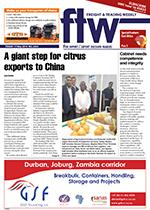The Port of Durban’s cargo volumes for the container, liquid bulk and dry bulk sectors have shown strong growth over the past year according to recent data released by Transnet National Ports Authority (TNPA). But according to David Watts, customs port and maritime consultant to the SA Association of Freight Forwarders, the substantial increase in recorded volumes is in fact only marginal over the long term, considering the stagnation experienced since the 2009 global recession. Lance Pullan of data management and consultancy company Linernet, agrees that volumes have not recovered to pre-2009 levels. “Unfortunately there are no consistently accurate records from TNPA of their volumes before 2014 and consequently it’s not possible to show graphically the lack of growth in the long term.” TNPA reported that the port’s container volumes had risen 9.5% for the year ending December 2018 to 2 956 670 TEUs compared to the 2 699 978 TEUs handled in 2017. Container imports grew by 10% and exports by 17%, representing the highest volumes handled by the port in the last seven years. According to TNPA dry bulk volumes grew 5.8%, while imports remained fairly stable. Liquid bulk volumes grew 3.1% from 28.231 kilolitres in 2018 to 29 million kilolitres in 2019. Durban port also recorded 4% growth in automotive imports and 15% growth in exports, excluding transhipment and coastwise cargo. The port handled just over 487 000 units in 2018, the highest throughput since 503 000 units were moved in 2013. Breakbulk volumes were relatively on par with 2017 as some cargo has migrated to containerisation and dry bulk sectors. Port of Durban acting port manager, Nokuzola
Nkowane, said the port would continue to work with terminal operators and other stakeholders “to ensure improvements in terminal productivity levels for quicker ship turnaround times”. “Operational efficiencies are the focus to drive volume performance,” Nkowane said. Watts said the cargo statistics provided by TNPA were drawn from cargo dues billing and would therefore reflect a marginal difference to actual month on month statistics. However, he said there was no reason to doubt their accuracy. “As far as TEUs are concerned 2018 saw the long-awaited increase from 2017 volumes of 2.7 million to 2.95 million with the increase in exports slightly above that of imports. I say “long awaited” as the
number for 2008 was 2.64 million TEUs so for the ten years to 2017 the volume increase was only slightly over 2% overall,” Watts said. “Clearly the impact of the 2009 recession and local economic conditions really constrained traffic flows. It is a little bit of hyperbole for Transnet to claim the latest increase had anything to do with them – welcome though it certainly was,” Watts said. He added that it was a concern that the figures for the first two months of 2019 had reflected a sharp year on year decline of 16.8% to 433 189 TEUs down from 520 567 TEUs during January/February 2018. A local port stakeholder, who asked not to be named, said that there was some speculation among exporters that the TNPA figures were “not all they are cracked up to be”. “Some companies are engaging companies to compile their own statistics so that they can argue whether they are correct or not,” he said. He added that factors such as adverse weather conditions including strong winds had hampered operations at the port over the past year.
Total volumes in 2018 increased by 9.52% in the calendar year and 2.68% in the financial year versus 2017 figures. When viewed in conjunction with total South African volumes, volumes through the port of Durban have contributed the bulk of the growth of TNPA nationally.


